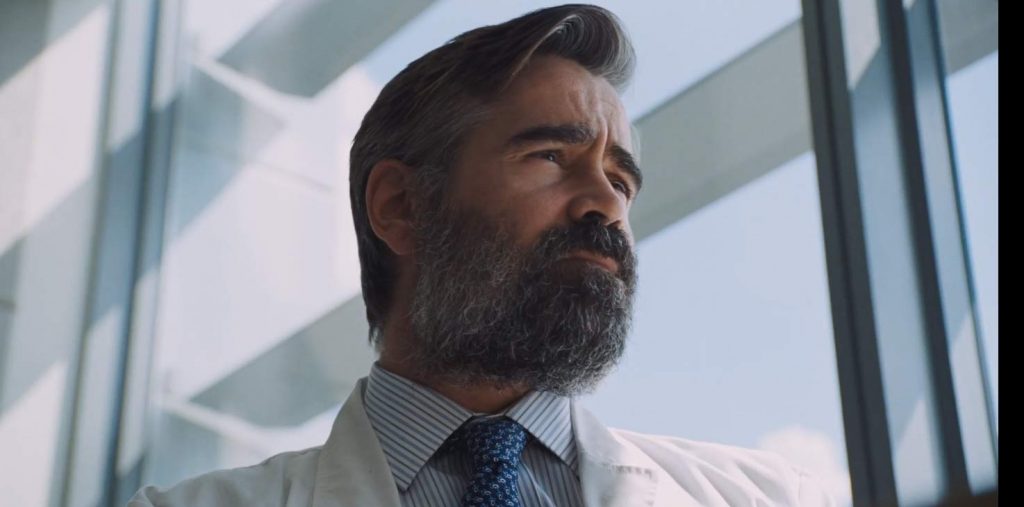Film can be such a literal medium at times that the more subtler forms of the fantastic – those stories that do not rely on overwrought special effects – can divide viewers. This was the case with Yorgo Lanthimos last film, The Lobster, set in a dystopian spa for lonely hearts, which blended black comedy, fable and Bunuel-like surrealism. The film took audiences and critics into a world that looked familiar, but one reflected back to us in dreamy fragments. Enough viewers understood The Lobster to make it a breakout film. Lathimos continues to transcend expectations with The Killing of a Sacred Deer, which audaciously draws inspiration from Kubrick, particularly 2001, The Shining and Eyes Wide Shut, for much of its first half.
Lanthimos takes us into almost banal world of upper middle class American suburbia, but it is one where the linings have been turned inside out. Steven (Colin Farrell) is a brilliant heart surgeon married to Anna (Nicole Kidman), who appears to be the ultimate stay-at-home wife. Outside of the operating theatre, Steven is a bit of a dullard, prone to narcoleptic discussions about luxury watches with colleagues. Yet he seems to have a double life when we discover him meeting the teenage Martin (Barry Keoghan), who he treats to private lunches and expensive gifts. Martin turns out to be the son of a patient who died during surgery and Steven continues to stay in contact due to a sense of guilt and duty that will end in tragedy. Tragedy, of the classic Greek kind, will soon loom large as Martin is introduced to Steven’s family, particularly for their two children, Kim (Raffey Cassidy) and Bob (Sunny Suljic).
The Killing of a Sacred Deer is arguably Lanthimos most provocative film to date. Working again with co-writer, Efthymis Filippou, the two have fashioned a revenge story that gains its horrific power by keeping the viewer at a cool distance like witnesses to an accident in progress. Farrell and Kidman are pitch-perfect as a married couple shaken out of their near catatonic complacency by Martin’s arrival. As played by the remarkable Keoghan, Martin underscores his brand of adolescent precociousness with insidious menace and cunning. His scenes remind one of the ambiguous stranger or guest found in Harold Pinter plays or films like Pier Paolo Pasolini’s Teorema or Roman Polanski’s Rosemary’s Baby.
While this is a film that wears its influences proudly, it is more than just a homage to arthouse past. What Lanthimos and Filippou are exploring in the Sacred Deer is the power of primal ritual, particularly as it applies to guilt and responsibility. Martin, the father surrogate of a broken family (we see his lonely mother (Alicia Silverstone) trying to woo Steven in a desolate meeting), is coming to collect a moral debt from Steven and Anna and in doing so, assert not just his authority, but claim his identity as an adult.
Sacred Deer’s creeping horror owes much to a visual strategy that continually alters our sense of reality. A business function is shot like a coronation. A meeting with a family friend in a diner becomes a chilling power exchange. The sanctuary of a modern hospital is lit to resemble a kingdom about to undergo a sudden change in regime. While the banter between family, friends and professional colleagues is delivered in near monotone as if the laws of time and space have subtly altered and science and knowledge are to give way to superstition and magic.
Darren Aronofsky’s Mother! also looked at repressed forces overwhelming the order of a seemingly stable and happy family unit, but Lathimos film is likely to stay in the memory longer. As bizarre as The Killing of a Sacred Deer seems (you will never, for example, hear the phrase “general anesthetic” quite the same way again), scenes all fit together like a carefully designed puzzle. In its final moments, The Killing of a Sacred Deer suggests the conundrums are the ones we somehow find imperfect solutions to; where despite the cost, we somehow survive and move forward as if in a waking dream.
Director: Yorgos Lanthimos
Writers: Yorgos Lanthimos, Efthymis Filippou
Stars: Nicole Kidman, Alicia Silverstone, Colin Farrell, Barry Keoghan, Raffey Cassidy
Lee Hill is a writer and consultant based in London. In addition to contributing to outlets as varied as SensesofCinema, Sight and Sound, and Resonance FM, he is the author of A Grand Guy: The Art and Life of Terry Southern (2001) and Easy Rider: A BFI Modern Classic (1996)
